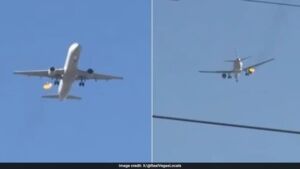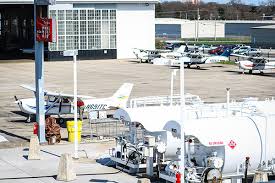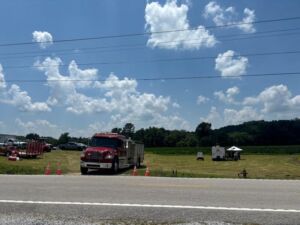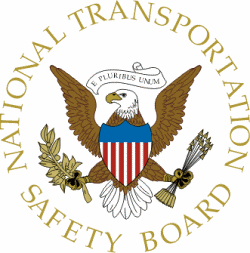These are your stories for today...
Be safe out there!
Tom
American Airlines Flight Returns to Las Vegas After Mid-Air Engine Fire
The airline said that the plane was carrying 153 customers and six crew members.
Edited by: Srishti Singh Sisodia
An American Airlines flight with 159 people on board was forced to return to Las Vegas on June 25 after one of its engines caught fire mid-air. Viral videos show flames and smoke trailing the aircraft.
Flight 1665 landed safely at Harry Reid International Airport with no injuries reported. The airline cited a mechanical issue.
The airline said that the plane was carrying 153 customers and six crew members. It was scheduled to fly from LAS to Charlotte Douglas International Airport (CLT).
"The aircraft taxied to the gate under its own power and customers deplaned normally," the airline added. "We appreciate the professionalism of our crew and thank our team who are working to get our customers to their destinations as quickly as possible."
The Federal Aviation Authority (FAA) and American Airlines' maintenance team would investigate the incident as the aircraft was taken out of service.
"American Airlines Flight 1665 returned safely to Harry Reid International Airport in Las Vegas around 8:20 a.m. local time on Wednesday, June 25, after the crew reported an engine issue," the agency said in a statement.
"The Airbus A321 was headed to Charlotte Douglas International Airport. The FAA will investigate."
Plane hit with "unexpected turbulence"
Another American Airlines flight on Sunday experienced "unexpected turbulence" and five people aboard were hospitalised.
The plane, American Airlines Flight 1286, was flying from Miami to Raleigh-Durham in North Carolina when the plane hit turbulence, Fox News Digital reported quoting a spokesperson.
In a statement, the FAA noted that the plane landed safely at Raleigh-Durham International Airport at around 10:50 pm (local time) "after the crew reported possible injuries to cabin crew and passengers due to turbulence".
While describing their experience to WRAL News, one passenger said, "It was like being on the top of a roller coaster and going down." "It sounded like we hit something and then we just dropped in the air."
Pilot Okay After Plane Crash at Unionville Municipal Airport
By Donna Savits
A small plane crash near Lake Thunderhead on Wednesday afternoon had a surprisingly good outcome — the pilot walked away with only a few cuts.
on Wednesday afternoon had a surprisingly good outcome — the pilot walked away with only a few cuts.
It happened around 2:30 p.m. at the Unionville Municipal Airport. The pilot, 49-year-old Cody Veach from Corydon, Iowa, was trying to land his single-engine aircraft when things didn’t go as planned. He says the plane bounced during his first landing attempt, so he pulled up and circled around to try again.
That’s when trouble hit. As he came back in, strong winds from Lake Thunderhead seem to have pushed the plane off course, causing it to crash into trees near the airport.
Despite the rough landing, Veach was able to get out on his own and is expected to be just fine. He was the only person onboard.
The flight began in Mt. Vernon, Missouri, and was headed to Unionville. Emergency crews responded quickly and were warned to stay clear of the wreckage because the aircraft has a ballistic parachute system onboard — a safety feature located in the tail of the plane.
Federal aviation officials will be on-site to investigate what led to the crash.
As a precaution, the City of Unionville has temporarily closed the airport until further notice.
courtesy KTVO
https://ottumwaradio.com/2025/06/pilot-okay-after-plane-crash-at-unionville-municipal-airport/
Helicopter pilot hits power lines, crashes while spraying crops in Hancock County
Adam Kight
HANCOCK COUNTY, Ky. (WEVV) — We are learning more about a helicopter crash that happened in Hancock County on Wednesday.
learning more about a helicopter crash that happened in Hancock County on Wednesday.
First responders confirm a helicopter crashed on Highway 169/144.
Authorities tell our news crew at the scene that the pilot was spraying crops with pesticides when it hit the lines and crashed in a corn field.
We're told the pilot suffered a broken leg, and was taken to the hospital by family before first responders arrived.
An update from Kenergy said a Big Rivers Electric Corporation line was knocked down by the helicopter.
A post from Kenergy initially said that 3,600 Hancock County customers were without power. After crews were able to isolate the outage, about 500 members remain without power while Kenergy and Big Rivers crews work to get the line repaired.
https://www.wevv.com/news/kentucky/helicopter-pilot-hits-power-lines-crashes-while-spraying-crops-in-hancock-county/article_fa8394aa-2eb8-43ff-a9ec-f970776abd59.html
NTSB Prelim: Aeronca 7AC
Pilot Took His 3-Year-Old Grandson For A Ride To Drop A Homemade Parachute Made From A 16 Ounce Water Bottle
Location: Waterman, IL Accident Number: CEN25FA198
Date & Time: June 7, 2025, 14:59 Local Registration: N1846E
Aircraft: Aeronca 7AC Injuries: 1 Fatal, 1 Serious
Flight Conducted Under: Part 91: General aviation - Personal
On June 7, 2025, about 1459 central daylight time, an Aeronca 7AC airplane, N1846E, sustained substantial damage when it was involved in an accident near Waterman, Illinois. The pilot was fatally injured, and the passenger was seriously injured. The airplane was operated as a Title 14 Code of Federal Regulations Part 91 personal flight.
According to witness reports, the pilot took his 3-year-old grandson for a ride to drop a homemade parachute made from a 16 ounce water bottle in a plastic grocery bag suspended below a homemade parachute made from black plastic. The parachute was dropped and the pilot reported over the radio that he was coming back around to see where the parachute landed. Witnesses observed the airplane maneuvering just west of the airport property; the right wing dipped, the nose dropped into a sudden dive, and an increase in engine power was heard. The wings leveled but the dive was not arrested before the airplane impacted terrain.
The airplane came to rest about 250 ft west of the Hinkley Airport (0C2), Hinkley, Illinois, property in a cultivated field. The top cowl over the engine was at a 37° nose down angle to the ground with the engine at the same attitude. The top portion of the fuselage from the firewall aft was deformed to the left. The left wing was in line with its normal position but with the fuselage deformity the left wing struts laid flat on the ground. The right wing remained attached to the fuselage, but the right wing struts exhibited impact damage, and the wing was angled downward with its wingtip nearly resting on the ground. All three landing gear separated from the airplane and the fuel tank was ejected about 10-15 feet forward of the airplane.
The airplane, engine, and propeller were examined at the accident site and no anomalies were found that would have prevented normal operation of the airplane.
FMI: www.ntsb.gov

Today in History
37 Years ago today: On 26 June 1988 Air France flight AF296Q, an Airbus A320, crashed during a flyby at Mulhouse-Habsheim Airport, France, killing 3 occupants; 133 survived the accident.
| Date: | Sunday 26 June 1988 |
| Time: | 14:45 |
| Type: | Airbus A320-111 |
| Owner/operator: | Air France, opf Air Charter International |
| Registration: | F-GFKC |
| MSN: | 009 |
| Year of manufacture: | 1988 |
| Total airframe hrs: | 22 hours |
| Cycles: | 18 flights |
| Engine model: | CFMI CFM56-5A1 |
| Fatalities: | Fatalities: 3 / Occupants: 136 |
| Other fatalities: | 0 |
| Aircraft damage: | Destroyed, written off |
| Category: | Accident |
| Location: | Mulhouse-Habsheim Airport - France |
| Phase: | Initial climb |
| Nature: | Demo/Airshow/Display |
| Departure airport: | Basel/Mulhouse Airport (BSL/LFSB) |
| Destination airport: | Basel/Mulhouse Airport (BSL/LFSB) |
| Investigating agency: | BEA |
| Confidence Rating: | Accident investigation report completed and information captured |
Narrative:
Air France flight AF296Q, an Airbus A320, crashed during a flyby at Mulhouse-Habsheim Airport, France, killing 3 occupants; 133 survived the accident.
The newly delivered Airbus A320, F-GFKC, was destroyed when it impacted trees during a low pass over the runway at Mulhouse-Habsheim Airport, France. A fire broke out, killing three occupants.
The Mulhouse Flying Club had requested Air France to perform a fly by at their air show at Mulhouse-Habsheim Airport on June 26, 1988.
Air France prepared a low speed pass with the gear down at 100 feet and the another pass at high speed in clean configuration. While Air France had performed more than twenty low passes since 1987, the altitude of 100 feet was not allowed according to regulations. French air safety regulations imposed a minimum VFR overflight height of 170 feet.
The fly by was to be performed using an Airbus A320, an aircraft model that was introduced by launching customer Air France in March 1988. F-GFKC was the third A320 in the fleet and had been delivered on June 23.
The flight crew scheduled to perform the demonstration flight were two captains: the head of A320 training subdivision (Pilot Flying) and a captain participating in the placing into service of the A320(Pilot Monitoring).
On board the flight were four cabin crew members and 130 passengers.
The aircraft took off from nearby Basle-Mulhouse Airport at 14:41 and climbed to 1000 feet agl. The crew started the descent three minutes later and Habsheim was in sight at 450 feet agl. The Pilot Monitoring informed the Pilot Flying that the aircraft was reaching 100 feet at 14:45:14. The descent continued to 50 feet 8 seconds later and further to 30-35 feet. Go-around power was added at 14:45:35. The A320 continued and touched trees approximately 60 meters from the end of runway 34R at 14:45:40 with a 14 degree pitch attitude and engines at 83% N1. The plane sank slowly into the forest and a fire broke out.
PROBABLE CAUSES: "The Commission believes that the accident resulted from the combination of the following conditions: 1) very low flyover height, lower than surrounding obstacles; 2) speed very slow and reducing to reach maximum possible angle of attack; 3) engine speed at flight idle; 4) late application of go-around power. This combination led to impact of the aircraft with the trees. The Commission believes that if the descent below 100 feet was not deliberate, it may have resulted from failure to take proper account of the visual and aural information intended to give the height of the aircraft."
